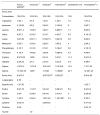Amino acids - Guidelines on Parenteral Nutrition, Chapter 4
- PMID: 20049071
- PMCID: PMC2795371
- DOI: 10.3205/000083
Amino acids - Guidelines on Parenteral Nutrition, Chapter 4
Abstract
Protein catabolism should be reduced and protein synthesis promoted with parenteral nutrion (PN). Amino acid (AA) solutions should always be infused with PN. Standard AA solutions are generally used, whereas specially adapted AA solutions may be required in certain conditions such as severe disorders of AA utilisation or in inborn errors of AA metabolism. An AA intake of 0.8 g/kg/day is generally recommended for adult patients with a normal metabolism, which may be increased to 1.2-1.5 g/kg/day, or to 2.0 or 2.5 g/kg/day in exceptional cases. Sufficient non-nitrogen energy sources should be added in order to assure adequate utilisation of AA. A nitrogen calorie ratio of 1:130 to 1:170 (g N/kcal) or 1:21 to 1:27 (g AA/kcal) is recommended under normal metabolic conditions. In critically ill patients glutamine should be administered parenterally if indicated in the form of peptides, for example 0.3-0.4 g glutamine dipeptide/kg body weight/day (=0.2-0.26 g glutamine/kg body weight/day). No recommendation can be made for glutamine supplementation in PN for patients with acute pancreatitis or after bone marrow transplantation (BMT), and in newborns. The application of arginine is currently not warranted as a supplement in PN in adults. N-acetyl AA are only of limited use as alternative AA sources. There is currently no indication for use of AA solutions with an increased content of glycine, branched-chain AAs (BCAA) and ornithine-alpha-ketoglutarate (OKG) in all patients receiving PN. AA solutions with an increased proportion of BCAA are recommended in the treatment of hepatic encephalopathy (III-IV).
Ein Proteinkatabolismus soll bei parenteraler Ernährung (PE) vermindert und anabole Stoffwechselprozesse gefördert werden. Standard-Aminosäure (AS)-Lösungen werden empfohlen, falls nicht in Sondersituationen z. B. bei schweren AS-Verwertungsstörungen oder bei angeborenen Stoffwechselstörungen spezifisch adaptierte AS-Lösungen eingesetzt werden müssen. Für erwachsene Patienten in ausgeglichenem Stoffwechselzustand wird eine AS-Zufuhr von 0,8 g/kg/Tag empfohlen, die auf 1,2–1,5 g/kg/Tag oder in Ausnahmefällen auch auf 2,0–2,5 g/kg/Tag gesteigert werden kann. Zur Gewährleistung einer angemessenen Utilisation von AS sollten ausreichend Nicht-Stickstoff-Energieträger zugegeben werden. Das angestrebte Verhältnis zwischen Stickstoff- und Energiezufuhr (Stickstoff-Kalorien-Verhältnis) sollte unter Normalbedingungen 1:100–1:130 (g N:kcal) bzw. 1:16–1:21 (g AS:kcal) betragen. Glutamin sollte parenteral bei kritisch Kranken, sofern indiziert, in Form von Peptiden verabreicht werden, wie z.B. 0,3–0,4 g Glutamin-Dipepetid/kg KG/Tag (entsprechend 0,2–0,26 g Glutamin/kg KG/Tag). Für Patienten mit akuter Pankreatitis, nach Knochenmarkstransplantation sowie für Neugeborene kann derzeit keine Empfehlung für eine Glutaminsupplementierung mit der PE ausgesprochen werden. Der Einsatz von Arginin als Supplement in der PE beim Erwachsenen ist derzeit nicht gerechtfertigt. Den N-azetylierten AS kommen als alternative Aminosäurenquellen zur Zeit nur eine begrenzte Bedeutung zu. Für eine generelle Verwendung von AS-Lösungen mit einem erhöhten Gehalt von Glyzin und verzweigtkettigten AS (VKAS) wie auch für Ornithin-α-Ketoglutarat (OKG) besteht keine gesicherte Indikation. Die Wirksamkeit von AS-Lösungen mit erhöhtem Anteil an VKAS in der Behandlung der hepatischen Enzephalopathie (III–IV) wird empfohlen.
Keywords: amino acid metabolism (first pass); amino acids; branched-chain amino acids (BCAA); dipeptide.
Figures




References
-
- Bertolo RF, Chen CZ, Law G, Pencharz PB, Ball RO. Threonine requirement of neonatal piglets receiving total parenteral nutrition is considerably lower than that of piglets receiving an identical diet intragastrically. J Nutr. 1998;128(10):1752–1759. - PubMed
-
- Elango R, Pencharz PB, Ball RO. The branched-chain amino acid requirement of parenterally fed neonatal piglets is less than the enteral requirement. J Nutr. 2002;132(10):3123–3129. - PubMed
-
- Shoveller AK, Brunton JA, Pencharz PB, Ball RO. The methionine requirement is lower in neonatal piglets fed parenterally than in those fed enterally. J Nutr. 2003;133(5):1390–1397. - PubMed
-
- Wykes LJ, Ball RO, Menendez CE, Ginther DM, Pencharz PB. Glycine, leucine, and phenylalanine flux in low-birth-weight infants during parenteral and enteral feeding. Am J Clin Nutr. 1992;55(5):971–975. - PubMed
-
- Rand WM, Pellett PL, Young VR. Meta-analysis of nitrogen balance studies for estimating protein requirements in healthy adults. Am J Clin Nutr. 2003;77(1):109–127. - PubMed
Publication types
MeSH terms
Substances
LinkOut - more resources
Full Text Sources
Other Literature Sources
Medical

